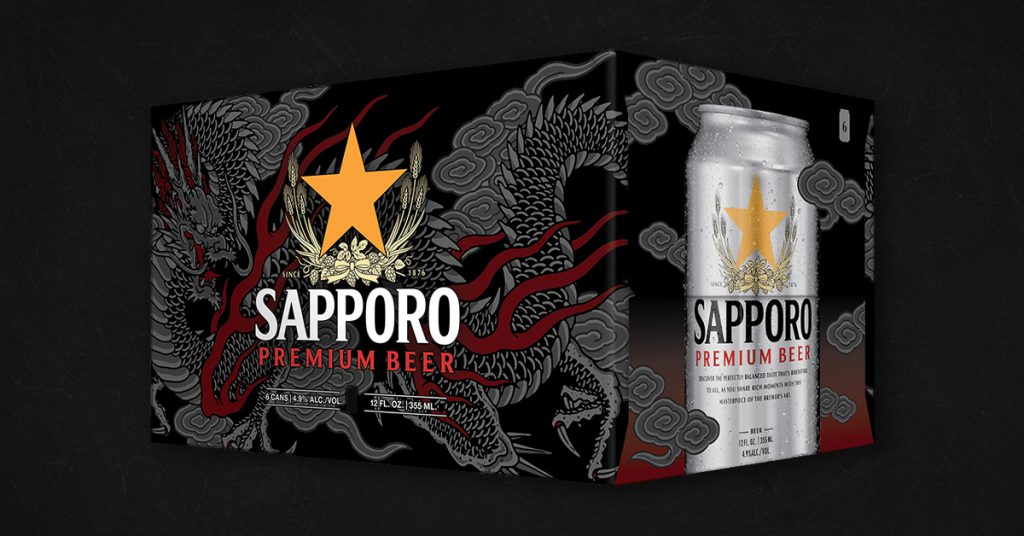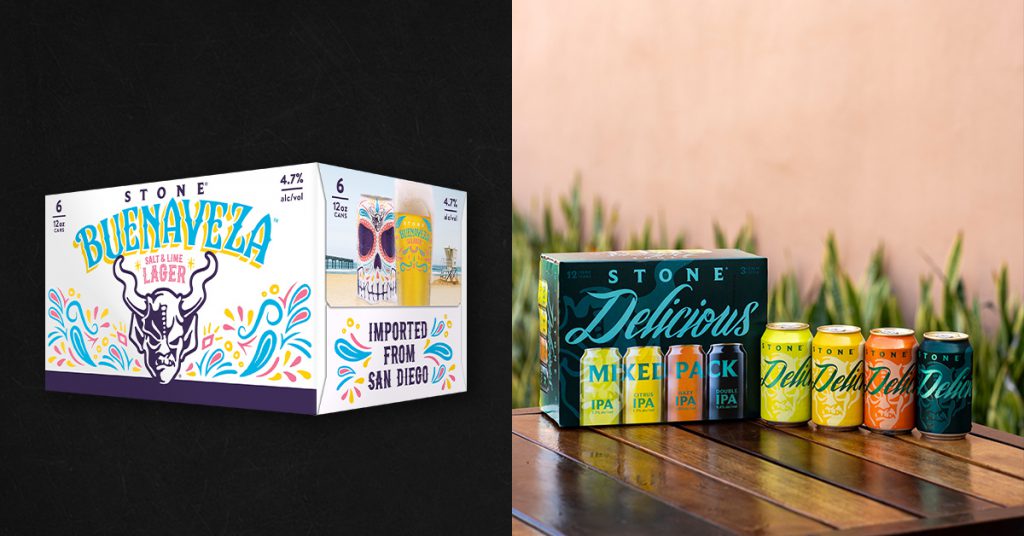
A year and a half post-merger, Sapporo-Stone is hitting its stride.
Sapporo beers are rolling off the packaging line at Stone’s East Coast production facility in Richmond, Virginia. The Escondido, California brewery is kegging Sapporo for the West Coast, and all package formats from both breweries are expected to be in market by summer, interim CEO Zachary Keeling told Brewbound.
Keeling took on the title of interim CEO in January, after the departure of Maria Stipp, who was named CEO of organic juice and shot company Suja Life last month.
Dollar sales of Sapporo have increased +20% at multi-outlet supermarkets, convenience stores and mass retailers in the 13 weeks ending January 27, according to data from market research firm NIQ shared by Stone.
Stone has increased volume +2% in NIQ-tracked channels in the 52-week period ending January 27, outpacing the craft category by +4.5%, according to the company.
The mandate underpinning recent success has been simple: bring it back to basics and focus on the core, including the gluten-reduced Delicious brand family and Buenaveza Salt & Lime Lager.
“Those core beers we think there’s tons of run room with establishing the Delicious brand family and that’s where our focus needs to be,” Keeling said. “And Buenaveza to me is still an incredible opportunity and has tons of space ahead of it, so we need to put our focus there.”
Stone has discontinued its beyond beer offerings, Buenavida Hard Seltzer and Buenafiesta Margaritas, Keeling said. Stone Hard Seltzer launched on April 1, 2021, while Stone Buenafiesta Margaritas rolled out in late 2022.
“I’m really happy that we tried these categories – I think we’ve learned from them and I think we learned what we’re good at and we learned where we could have done better,” Keeling said. “What we’re really good at is making really great beer and taking that to market so that’s what we’re going to concentrate on.”
Nationwide, Sapporo and Stone wholesaler networks are just 8% aligned, chief revenue officer Tom McReavy told Brewbound. The company is going to be “thoughtful” when assessing how to move forward because there are “tremendous distributor partners on both sides,” he added.
“We need to be with the best distributor partner in each market and honestly one that’s going to invest in our growth opportunities right alongside of us,” McReavy said. “Clearly, in some states, shipping Sapporo and Stone to 16, 17 distributors does not make the most sense, so we have to thoughtfully move towards that consolidation.”
Wholesaler consolidation is something that won’t come down the pike until Year Three at the earliest, he said. In 2023 – Year One of the combined business – Sapporo-Stone focused on integrating both companies’ teams.
Year Two “is really about execution of starting to get the commercial entity to sell to retailers and in a consistent fashion,” McReavy said.
Despite minimal middle-tier overlap, retailers appreciate receiving combined Sapporo-Stone pitches, he said.
“It is a tremendous opportunity as a sales entity to be able to walk in and talk about Sapporo and Stone in the same breath,” McReavy said. “When we’re talking to c-stores we have an incredible lineup of craft 19.2s and we also have an iconic 22 oz. steel can from Sapporo.
“It’s a game of scale, so when we’re able to go in and talk to our retail or our distributor partners, and we’re able to talk about both, we get a little bit more attention,” he continued. “We’re seeing that attention yield results and again, that momentum that we’re seeing in depletions.”
Below are updates on both brand families.

Sapporo Unlocks Chain Potential
Sapporo is sourcing most of its growth in chains, where its 12-pack cans have increased points of distribution +20%, followed by 6-pack cans (+10%).
Depletions (sales to retailers) to off-premise chains increased +13% in 2023, and 2024 is off to an even stronger start with chain depletions +17% in January, according to the company, citing data from Vermont Information Processing (VIP).
Sapporo accounts for two-thirds of all dollars spent on Asian beer in NIQ-tracked channels in the U.S.
In the on-premise, the brand has seen “huge growth” in Asian cuisine chains including P.F. Chang’s and Benihana, and the company has an on-premise Sapporo sales team dedicated to sushi restaurants and other accounts specializing in Asian cuisine. All other sales employees sell both brands.
“Nearly half its business has been on-premise focused from a total brand perspective,” Keeling said. “And in total, Sapporo is about the same size as Stone.”
The company is embracing Sapporo’s affinity for food pairings in both on- and off-premise channels – a popular page in other import brands’ playbooks.
“Pretty much every off-premise chain account has a sushi takeout spot, and so we’re certainly going to lean into that but also, as one of our Stone brewers put it to me the other day, Sapporo pairs with everything,” McReavy said. “We have a huge opportunity to grow out from just a traditional sushi beer. I see the likes of Stella [Artois] and Peroni and what they’re able to do and I think that is clearly what we need to focus on.”
In January, Sapporo partnered with Japanese tattoo artist Tokyo Hiro to create the brand’s first-ever can 6-pack in the U.S. adorned with custom dragon art. Year of the Dragon can 6-packs increased points of distribution by +74%, according to data the company shared.
In off-premise NIQ-tracked channels, dollar sales of Sapporo can 12-packs have increased +37% in the 52 weeks ending January 27, and accelerated to +45% in the last 13 weeks.
Sapporo’s single-serve can is a top five import single-serve in grocery stores, and increased dollar sales +12% in the 13 weeks ending January 27, according to NIQ data shared by Stone.

Stone Zeroes in on Beer
Stone’s top priority is Buenaveza, followed by Stone IPA and the Delicious brand family.
“We realized there are some regionality to some of our beers,” McReavy said. “FML [Fear.Movie.Lions Hazy Double IPA] does very well in the Northeast, and if that was an opportunity for the team to go secure distribution, we’re clearly going to align with that, but from a national perspective, it’s Buenaveza, IPA and then the Delicious family.”
When the brewery’s specialty releases and Enjoy By series are excluded, Stone has recorded growth in “all internal region xAOC groupings,” with dollar sales up +2% in the west, +4% in central and +6% in the east in the 52 weeks ending January 27.
Several key markets have also recorded noteworthy growth in the same period:
- Southern California +5%;
- Texas +16%;
- Colorado +16%;
- Virginia +16%;
- Arizona +3%.
In addition to its standalone offerings, Stone has released two variety packs, a rotating IPA pack and the Delicious family variety pack. The IPA pack is the No. 2 craft can mixed 12-pack in NIQ-tracked channels. It increased dollar sales +36% in the 52 weeks ending January 27, according to NIQ data the company shared.
Stone IPA Variety Pack has about one-third the total distribution points of New Belgium’s Voodoo Ranger Hoppy Pack, the leading craft mix pack in off-premise scan data. In Stone’s home market of Southern California, the pack has outsold Voodoo Ranger Hoppy Pack by more than $1 million, according to NIQ data provided by Stone.
“People are looking for variety, and when we have the success on the variety 12-pack I believe that that is by extension then leading to success on our IPA,” McReavy said. “People try it in the variety [pack], they go out and they pick it up.”
Stone IPA remains the company’s largest brand and accounted for 21% of all shipments in 2023, a spokesperson told Brewbound. It is roughly twice as large as Buenaveza or Delicious in independent retailers beyond California.
As distributed draft beer is challenged nationwide, Buenaveza’s draft depletions increased +12% last year despite cycling against a national limited-time offering at Buffalo Wild Wings in 2022. It accounts for about 30% of the brewery’s draft depletions, the spokesperson said.
The brand is the country’s No. 1 craft Mexican lager – a style with tailwinds going into 2024.
Additionally, the brewery has launched Stone Pilsner (4.7% ABV) in distributed package and kegs in Southern California and on draft at its Richmond taproom.
Stone’s own-premise business – which once had international reach via now-shuttered locations in Shanghai and Berlin – is “great,” Keeling said.
The company operates two Stone World Bistro & Gardens (at its Escondido headquarters and in Liberty Station, San Diego) and four taprooms (Oceanside, Pasadena, and two in San Diego – one on Kettner Boulevard and one at San Diego International Airport).
“The Stone facilities, they’re not taprooms, right?” Keeling said. “They’re humongous breweries or they’re restaurants with gardens. We’re very lucky to have them and they continue to be amazing businesses, let alone the more important fact they connect to the consumers on a day-to-day basis.”
Sapporo-Stone was the 23rd largest beer category vendor in multi-outlet grocery, mass retail and convenience stores in the 52 weeks ending January 28, according to market research firm Circana.